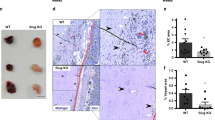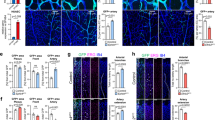Abstract
In sprouting angiogenesis, specialized endothelial tip cells lead the outgrowth of blood-vessel sprouts towards gradients of vascular endothelial growth factor (VEGF)-A1,2. VEGF-A is also essential for the induction of endothelial tip cells2, but it is not known how single tip cells are selected to lead each vessel sprout, and how tip-cell numbers are determined. Here we present evidence that delta-like 4 (Dll4)–Notch1 signalling regulates the formation of appropriate numbers of tip cells to control vessel sprouting and branching in the mouse retina. We show that inhibition of Notch signalling using γ-secretase inhibitors, genetic inactivation of one allele of the endothelial Notch ligand Dll4, or endothelial-specific genetic deletion of Notch1, all promote increased numbers of tip cells. Conversely, activation of Notch by a soluble jagged1 peptide leads to fewer tip cells and vessel branches. Dll4 and reporters of Notch signalling are distributed in a mosaic pattern among endothelial cells of actively sprouting retinal vessels. At this location, Notch1-deleted endothelial cells preferentially assume tip-cell characteristics. Together, our results suggest that Dll4–Notch1 signalling between the endothelial cells within the angiogenic sprout serves to restrict tip-cell formation in response to VEGF, thereby establishing the adequate ratio between tip and stalk cells required for correct sprouting and branching patterns. This model offers an explanation for the dose-dependency and haploinsufficiency of the Dll4 gene3,4,5, and indicates that modulators of Dll4 or Notch signalling, such as γ-secretase inhibitors developed for Alzheimer’s disease, might find usage as pharmacological regulators of angiogenesis.
This is a preview of subscription content, access via your institution
Access options
Subscribe to this journal
Receive 51 print issues and online access
$199.00 per year
only $3.90 per issue
Buy this article
- Purchase on Springer Link
- Instant access to full article PDF
Prices may be subject to local taxes which are calculated during checkout




Similar content being viewed by others
References
Ruhrberg, C. et al. Spatially restricted patterning cues provided by heparin-binding VEGF-A control blood vessel branching morphogenesis. Genes Dev. 16, 2684–2698 (2002)
Gerhardt, H. et al. VEGF guides angiogenic sprouting utilizing endothelial tip-cell filopodia. J. Cell Biol. 161, 1163–1177 (2003)
Gale, N. W. et al. Haploinsufficiency of delta-like 4 ligand results in embryonic lethality due to major defects in arterial and vascular development. Proc. Natl Acad. Sci. USA 101, 15949–15954 (2004)
Krebs, L. T. et al. Haploinsufficienct lethality and formation of arteriovenous malformations in Notch pathway mutants. Genes Dev. 18, 2469–2473 (2004)
Duarte, A. et al. Dosage-sensitive requirement for mouse Dll4 in artery development. Genes Dev. 18, 2474–2478 (2004)
Uv, A., Cantera, R. & Samakovlis, C. Drosophila tracheal morphogenesis: intricate cellular solutions to basic plumbing problems. Trends Cell Biol. 13, 301–309 (2003)
Carmeliet, P. & Tessier-Lavigne, M. Common mechanisms of nerve and blood vessel wiring. Nature 436, 193–200 (2005)
Lu, X. et al. The netrin receptor UNC5B mediates guidance events controlling morphogenesis of the vascular system. Nature 432, 179–186 (2004)
Torres-Vazquez, J. et al. Semaphorin-plexin signaling guides patterning of the developing vasculature. Dev. Cell 7, 117–123 (2004)
Llimargas, M. The Notch pathway helps to pattern the tips of the Drosophila tracheal branches by selecting cell fates. Development 126, 2355–2364 (1999)
Steneberg, P., Hemphala, J. & Samakovlis, C. Dpp and Notch specify the fusion cell fate in the dorsal branches of the Drosophila trachea. Mech. Dev. 87, 153–163 (1999)
Ghabrial, A. S. & Krasnow, M. A. Social interactions among epithelial cells during tracheal branching morphogenesis. Nature 441, 746–749 (2006)
Shawber, C. J. & Kitajewski, J. Notch function in the vasculature: Insights from zebrafish, mouse and man. Bioessays 26, 225–234 (2004)
Dovey, H. F. et al. Functional γ-secretase inhibitors reduce β-amyloid peptide levels in brain. J. Neurochem. 76, 173–181 (2001)
Searfoss, G. H. et al. Adipsin, a biomarker of gastrointestinal toxicity mediated by a functional γ-secretase inhibitor. J. Biol. Chem. 278, 46107–46116 (2003)
van Es, J. H. et al. Notch/γ-secretase inhibition turns proliferative cells in intestinal crypts and adenomas into goblet cells. Nature 435, 959–963 (2005)
Kopan, R. & Ilagan, M. X. G. γ-secretases: proteasome of the membrane? Nature Rev. Mol. Cell Biol. 5, 499–504 (2004)
Claxton, S. & Fruttiger, M. Periodic Delta-like 4 expression in developing retinal arteries. Gene Expr. Patterns 5, 123–127 (2004)
Shutter, J. R. et al. Dll4, a novel Notch ligand expressed in arterial endothelium. Genes Dev. 14, 1313–1318 (2000)
Lawson, N. D. et al. Notch signaling is required for arterial-venous differentiation during embryonic vascular development. Development 128, 3675–3683 (2001)
Domenga, V. et al. Notch3 is required for arterial identity and maturation of vascular smooth muscle cells. Genes Dev. 18, 2730–2735 (2004)
Krebs, L. T. et al. Notch signaling is essential for vascular morphogenesis in mice. Genes Dev. 14, 1343–1352 (2000)
Limbourg, F. P. et al. Essential role of endothelial Notch1 in angiogenesis. Circulation 111, 1826–1832 (2005)
Monvoisin, A. et al. VE-cadherin-CreERT2 transgenic mouse: A model for inducible recombination in the endothelium. Dev. Dyn. 235, 3413–3422 (2006)
Wolfer, A. et al. Inactivation of Notch1 in immature thymocytes does not perturb CD4 or CD8 T cell development. Nature Immunol. 2, 235–241 (2001)
Duncan, A. W. et al. Integration of Notch and Wnt signaling in hematopoietic stem cell maintenance. Nature Immunol. 6, 314–322 (2005)
Itoh, M. et al. Mind Bomb is a ubiquitin ligase that is essential for efficient activation of Notch signaling by Delta. Dev. Cell 4, 67–82 (2003)
Weijzen, S. et al. The notch ligand Jagged-1 is able to induce maturation of monocyte-derived human dendritic cells. J. Immunol. 169, 4273–4278 (2002)
Grunstein, J., Masbad, J. J., Hickey, R., Giordano, F. & Johnson, R. S. Isoforms of vascular endothelial growth factor act in a coordinate fashion to recruit and expand tumor vasculature. Mol. Cell. Biol. 20, 7282–7291 (2000)
Ferrara, N. Vascular endothelial growth factor: Basic science and clinical progress. Endocr. Rev. 25, 581–611 (2004)
Acknowledgements
We thank F. Radke for providing Notch1floxed/floxed mice. Support from the following foundations and granting agencies is acknowledged: Swedish Cancer Society, Association for International Cancer Research, European Union, the Novo Nordisk, Strategic Research, Söderberg, Hedlund, Wallenberg and Inga-Britt and Arne Lundberg Foundations (to C.B.); National Institutes of Health (US, NIH) and JH (USPHS National Research Service Award) (to L.I.-A.). H.G., L.-K.P. and P.L. are supported by Cancer Research UK. We acknowledge the Swegene Centre for Cellular Imaging at Gothenburg University for the use of imaging equipment, and the Light Microscopy Service and Peptide Synthesis Laboratory, London Research Institute (Cancer Research UK) for technical assistance.
Author information
Authors and Affiliations
Corresponding authors
Ethics declarations
Competing interests
[Competing Interests Statement: M.H. and M.K. are employed by AngioGenetics Sweden AB. C.B. receives funding from and is a consultant of AngioGenetics Sweden AB.]
Supplementary information
Supplementary Information
This file contains Supplementary Methods, Supplementary Figures S1-S11 with Legends and additional references. (PDF 7910 kb)
Rights and permissions
About this article
Cite this article
Hellström, M., Phng, LK., Hofmann, J. et al. Dll4 signalling through Notch1 regulates formation of tip cells during angiogenesis. Nature 445, 776–780 (2007). https://doi.org/10.1038/nature05571
Received:
Accepted:
Published:
Issue Date:
DOI: https://doi.org/10.1038/nature05571
This article is cited by
-
Role of cell rearrangement and related signaling pathways in the dynamic process of tip cell selection
Cell Communication and Signaling (2024)
-
The Statistical Theory of the Angiogenesis Equations
Journal of Nonlinear Science (2024)
-
Role of endothelial PDGFB in arterio-venous malformations pathogenesis
Angiogenesis (2024)
-
The interplay of cells, polymers, and vascularization in three-dimensional lung models and their applications in COVID-19 research and therapy
Stem Cell Research & Therapy (2023)
-
Biomechanical stimulation promotes blood vessel growth despite VEGFR-2 inhibition
BMC Biology (2023)
Comments
By submitting a comment you agree to abide by our Terms and Community Guidelines. If you find something abusive or that does not comply with our terms or guidelines please flag it as inappropriate.



